Roku Not Working
In the ever-expanding world of digital streaming, Roku has emerged as a leading player, captivating users with its user interface and a wide array of content options. However, like any technology, it’s not immune to problems. Users often find themselves puzzling over the frustrating question: Why is my Roku not working? This common quandary can stem from various technical snags, from connectivity issues to system errors, making it a frequent topic among Roku support forums.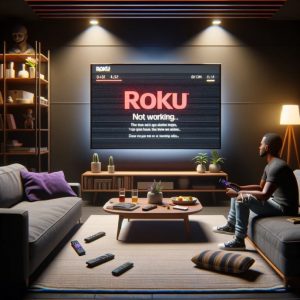
In this blog, we delve into the intricacies of Roku issues that can disrupt your viewing experience. Whether it’s a software hiccup or a hardware malfunction, understanding the roots of these disruptions can be crucial. We aim to not only outline the typical scenarios where you might find Roku not working but also to provide actionable solutions. By addressing the question Why is my Roku not working? we hope to help you minimize downtime and maximize enjoyment of your Roku device.
Through this exploration, we’ll shed light on the spectrum of difficulties users may face and offer a preview of the comprehensive troubleshooting steps outlined in later sections. Stay tuned as we guide you through resolving common issues and getting back to enjoying your favorite shows and movies without hassle.
Identifying Common Issues for Roku Not Working
Navigating through the challenges of a malfunctioning Roku devices can be frustrating, especially when you’re eager to unwind with your favorite show or movie. Recognizing the common issues is the first step towards a solution. In this section, we explore various problems that might lead you to think, Why is my Roku not working? From internet connectivity woes to hardware malfunctions, we cover all bases to ensure you’re equipped to tackle these challenges head-on.
-
Internet Connectivity Problems:
One of the most frequent culprits behind Roku not working is internet connectivity issues. To determine if your Roku is properly connected to the internet, navigate to the network settings in your device’s menu. If you discover a connection problem, several Roku troubleshooting steps can be helpful, such as rebooting your modem or enhancing the Wi-Fi signal strength near your Roku device. To know more about Roku connectivity lssues, you can read our comprehensive blog on Roku Not Connecting to Internet.
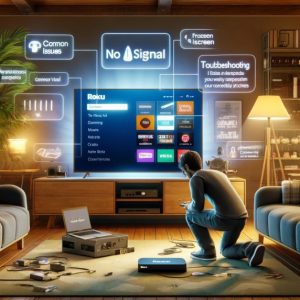
-
Software and Firmware Glitches:
Roku problems can often be traced back to outdated software or firmware glitches. Regularly checking for updates is crucial and can be done through the settings menu of your Roku. If you encounter stubborn glitches, a simple restart of your Roku might clear up these issues, restoring functionality swiftly.
-
Hardware Issues:
Hardware malfunctions can range from overheating to troubles with the HDMI port. Signs of such issues include an unusually hot device or a compromised picture quality on your screen. If basic Roku troubleshooting doesn’t resolve these, it may be time to consider professional repairs or even a replacement.
-
Account and Setup Issues:
Improper setup or account issues can also lead to frustrations with Roku not working Double-checking setup configurations and ensuring your Roku account is in good standing are straightforward measures to prevent or resolve these Roku TV issues.
By identifying and understanding these common Roku problems and knowing how to tackle them with effective troubleshooting for Roku, you can enhance your streaming experience and reduce the likelihood of future disruptions. Keep these tips in mind as we move to the next section, where we’ll delve deeper into step-by-step troubleshooting guides to address these issues more thoroughly.
Step-by-Step Troubleshooting for Roku Not Working
When faced with the frustrating realization that your Roku does not work as expected, knowing how to methodically troubleshoot can be a game-changer. This section provides a detailed guide to tackle the most common problems, ensuring your device operates smoothly. Whether it’s Roku not connecting or software hiccups, follow these steps to get your Roku back in action.
-
Restarting Your Roku Device
Restarting your Roku can resolve a myriad of issues, from Roku connectivity issues to software glitches. Here’s how to do it properly: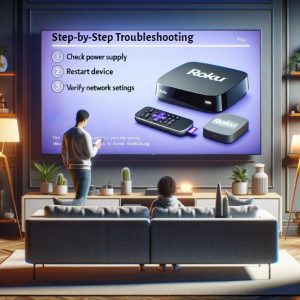
-
- On your Roku remote, press the Home button.
- Go to Settings > System > System restart.
- Select ‘Restart’ and allow your Roku to complete the process.
This method often clears temporary malfunctions that cause your Roku not to work.
-
Checking Network Settings
If you’re experiencing Roku connection problems, verifying your network settings is crucial. Follow these steps:
-
- Navigate to Settings on your Roku menu.
- Select Network, and then ‘Check connection’.
- Roku will test both your internet connection and network speed, providing you with a status report.
This helps diagnose whether the issue is related to Roku not connecting to your network or the internet at large.
-
Updating Roku Software
Keeping your Roku’s software up-to-date is vital for smooth operation:
-
- Press the Home button on your remote.
- Select Settings > System > System update.
- Choose ‘Check now’ to manually check for update. If an update is available, follow the prompts to install.
Regular updates can prevent and fix bugs that might cause your Roku not working.
-
Factory Reset
As a last resort, performing a factory reset can help resolve deeper issues if your Roku will not work:
-
- Navigate to Settings > System > Advanced settings.
- Select ‘Factory reset’ and follow prompts to reset your device.
Take note that, a factory reset will erase all your personal settings and data, so use this option only if necessary.
By following these steps, you should be able to address the most common issues related to Roku connectivity issues, restoring your access to seamless streaming entertainment.
Advanced Troubleshooting for Roku Not Working
Even after basic troubleshooting, some persistent problems may continue to hinder your Roku’s performance. This section delves into advanced techniques that go beyond conventional methods, aiming to resolve more complex issues when Roku does not work effectively or consistently. Here’s how you can tackle these challenges using deeper troubleshooting methods.
Enhancing Wi-Fi Connectivity for Roku Devices
Weak Wi-Fi signals can lead to poor streaming quality and frequent buffering, especially if your Roku will not connect to the internet reliably. Here are some advanced tips to enhance your Wi-Fi connectivity: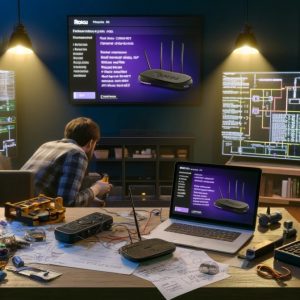
-
Reposition Your Router:
Move your Wi-Fi router closer to your Roku device or remove obstacles that might be blocking the signal.
-
Use a Wi-Fi Extender:
For larger homes, using a Wi-Fi extender can boost the signal reach, ensuring strong connectivity to your Roku device.
-
Switch Wi-Fi Channels:
Sometimes, simply changing the channel on your router can reduce interference and improve performance.
-
Dealing with Persistent Software Issues
If common fixes do not resolve Roku not working issues due to software glitches, reinstalling Roku’s operating system might be necessary. Here’s how to reinstall the Roku OS:
-
- Access the secret screen by pressing the Home button five times, followed by the Fast Forward button three times and Rewind button twice.
- Select the ‘Factory reset’ option to reinstall the operating system, ensuring you have backed up any necessary data beforehand.
This can resolve deeper software problems that prevent Roku from connecting to TV effectively.
-
Using Roku’s Secret Menus
Roku’s secret menus offer advanced users the ability to fine-tune their device settings beyond what’s available through the standard menu. This is particularly useful for debugging or enhancing device functionalities:
-
-
Access the Secret Menu:
Press the Home button five times, followed by the Up, Down, Up, Down, Up.
-
Adjust Developer Settings or Reset DRM:
Use these hidden menus to adjust developer options or reset DRM controls which can help when AirPlay is not working on Roku.
-
Leveraging these advanced troubleshooting techniques can significantly improve your Roku’s performance and solve issues that persist even after standard fixes. These methods target the more technical aspects of Roku’s operation, helping to ensure a smoother, more reliable streaming experience.
Preventive Measures and Best Practices for Roku
To keep your Roku operating at its best, it’s not only about handling issues as they arise but also about taking proactive steps to prevent common problems. These best practices and routine maintenance tips can help avoid frequent concerns such as Roku does not work, sound Issues, and other connectivity issues, ensuring your device performs well over the long term.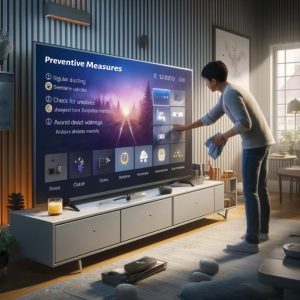
Tips to Prevent Common Roku Issues
-
Regular Roku Software Updates:
Ensure your Roku device is always running the latest software version. This can prevent many software-related issues, such as Roku not working or no sound.
-
Optimize Your Network:
Maintain a strong Wi-Fi connection by regularly updating your router’s firmware, positioning your router optimally, and reducing network congestion to avoid Roku connectivity issues.
-
Avoid Overheating:
Keep your Roku device in a well-ventilated area away from other heat-generating electronics. Overheating can cause multiple issues, including Roku TV no sound and impaired functionality. To know more about overheating lssues, you can read our comprehensive blog on Roku Overheating.
-
Regular Roku Maintenance Routines for Long-Term Device Health
-
Dust Regularly:
Keep your Roku device and its ports clean and free from dust. This simple action can improve longevity and functionality.
-
Power Cycle Regularly:
Periodically, unplug your Roku device for a few minutes before plugging it back in. This can help clear caches and resolve minor glitches that might cause the device to say Roku will not work.
-
Check and Secure Connections:
Regularly check that all cables are securely connected, and replace any worn-out cables to avoid issues such as no sound on Roku.
-
Implementing these preventive measures and adhering to regular maintenance routines can significantly reduce the likelihood of facing common issues. These practices ensure that your Roku device remains in excellent working condition, providing a seamless streaming experience free from disruptions like no sound on Roku TV or other frustrating glitches. By being proactive, you can enjoy uninterrupted entertainment and get the most out of your Roku device.
FAQs
Q1. What should I do if my Roku Does Not Work?
- A: If your Roku does not work, first check your internet connection and ensure your device’s software is up-to-date.
Q2. Why is there no sound on Roku TV when streaming content?
- A: If there’s no sound on Roku TV, check the audio settings and cables to ensure they are correctly connected and configured.
Q3. How can I fix Roku Not Working when all other devices are fine?
- A: For Roku not working, restart your Roku device and router, and if the problem persists, check for system updates.
Q4. What steps should I take if Roku TV no sound is an issue during playback?
- A: If you experience Roku TV no sound, adjust the audio settings in the menu, and ensure your HDMI or optical cables are securely connected.
Q5. What can cause Roku will not work and how can I resolve it?
- A: If your Roku will not work, this could be due to power issues, an outdated app, or firmware problems. Resetting the device might help.
Q6. Why do I get no sound from Roku when using apps like Netflix or YouTube?
- A: No sound from Roku in specific apps often indicates an app-specific setting or an update is needed. Restart the app or check for updates.
Q7. How do I address Roku No Sound On TV during live broadcasts?
- A: To fix Roku no sound on TV, ensure the mute function is not activated and adjust the audio settings for external speakers if used.
Q8. What should I do if the Roku Sound Not Working issue appears suddenly?
- A: If the Roku sound not working issue starts suddenly, check to see if an automatic update occurred and revert to previous settings if possible.
Q9. How can I troubleshoot when my Roku App Not Connecting to TV?
- A: If the Roku app not connecting to TV, ensure your Roku device is connected to same Wi-Fi network as your smartphone or tablet.
Q10. Why won’t my Roku TV Turn On, and how can I fix it?
- A: If Roku TV won’t turn on, ensure the power cord is plugged in securely and the socket is functioning. A hard reset might also be necessary.
Conclusion
Navigating through the challenges of a Roku device that exhibits issues such as Roku does not work, sound Problem, or connectivity problems can be frustrating. However, with the detailed insights and troubleshooting methods we’ve discussed, you’re now better equipped to diagnose and resolve these common issues effectively.
We’ve explored a range of scenarios from Roku not working due to software glitches, connectivity issues, and even hardware problems. Each section provided you with practical steps to not only fix but also prevent these issues from recurring, ensuring your Roku experience is as seamless and enjoyable as possible. Remember, many issues like Roku not working can often be resolved with easy solutions such as checking connections, updating software, or restarting your device.
In addition to reactive troubleshooting, we emphasized the importance of preventive measures and regular maintenance. These practices are crucial in preserving the long-term health of your Roku device, preventing issues like Roku sound not working or other common malfunctions.
In conclusion, while encountering problems like Roku sound not working or finding that your Roku does not work can disrupt your streaming experience, these challenges are often manageable with the right knowledge and approach. By applying the troubleshooting steps and preventive tips discussed, you can ensure that your Roku continues a reliable source of entertainment for years to come. Whether you’re watching your favorite movies, shows, or streaming live events, maintaining your Roku device in good working order will help you enjoy all that Roku has to offer without interruption.
To know more about Why Roku Not Working and resolve its related issues, visit Roku Support Page.


Nancy Jones
I’ve tried everything but my Roku does not work. There’s no power indicator, and it seems completely dead. What’s my next step to troubleshoot, considering I’ve checked the power connections?
Support Admin
When facing a situation where your Roku does not work at all, and after ensuring that the power connections are secure and the outlet is functional, the next steps involve more in-depth troubleshooting. If there’s still no power light or response from your Roku, it’s crucial to try a different power cable if available, as the issue might be with the cable itself rather than the Roku. Another method to try is connecting your Roku device to a different TV or HDMI port to rule out possible issues with the TV’s HDMI port. If these steps yield no success, it might indicate a hardware failure within the Roku device, in which case contacting Roku’s customer support for potential repair or replacement options would be advisable.
Charles anderson
After several attempts and using different power outlets, my Roku TV won’t turn on. The standby light is there, but nothing happens when I press the power button. What specific actions can I take next to try and get it running?
Support Admin
If your Roku TV won’t turn on but shows a standby light, indicating it’s receiving some power, a more detailed reset might help. Beyond just unplugging the TV, consider a “soft reset” by pressing and holding the power button on the TV itself (not the remote) for about 30 seconds. This can sometimes force the TV to restart and clear any temporary glitches. If this doesn’t work, looking for a manual reset button on the TV or accessing the boot menu using a combination of button presses (specific to your TV model) could be the next steps. These actions can trigger a deeper reset which might solve the issue. If these measures fail, the problem might be more serious, possibly related to the TV’s power supply or mainboard, requiring professional service.